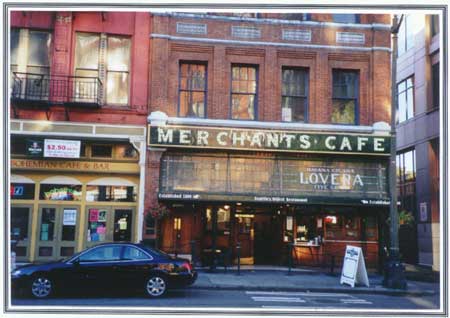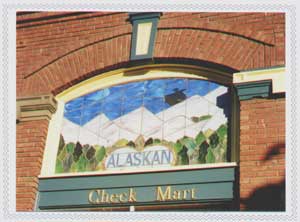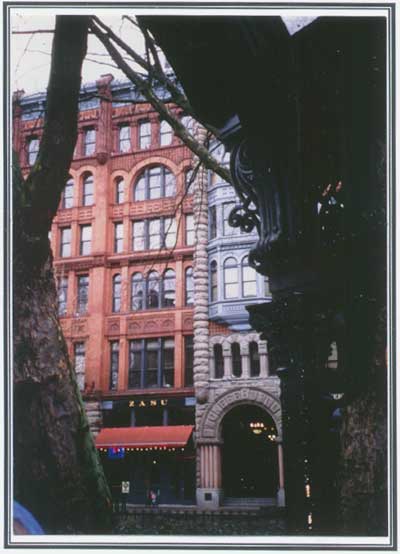HARD DRIVE TO THE KLONDIKE:
PROMOTING SEATTLE DURING THE GOLD RUSH
A Historic Resource Study
for the Seattle Unit of the
Klondike Gold Rush National Historical Park

CHAPTER FOUR
Building the City
"Seattle is the result of a patriotic, unselfish, urban spirit which has been willing to sacrifice in order to gain a desired end -- the upbuilding of a great city....Seattle has well-paved streets, a thorough and satisfactory street car system, large and handsome business blocks, and residence districts adorned by palatial homes and green and velvety lawns."- Daniel L. Pratt, "Seattle, The Queen City,"
The Pacific Monthly, 1905
Seattle changed more during the gold-rush era than in any other period in its history. The rapid economic and population growth of the late nineteenth and early twentieth centuries spurred the development of the city's infrastructure, transforming it from a town to a metropolis. As one historian observed, if Rip Van Winkle had appeared in 1883 after a 30-year absence, he would have easily recognized what he saw: a town dependent on the lumber industry and water transportation. Similarly, if he awakened in the 1940s after a 30-year absence, he would find the city bigger but not fundamentally changed. However, if he fell asleep in 1880 and returned in 1910, he would not have known where he was. Although natural landmarks such as Mount Rainer and Puget Sound remained in their familiar positions, "Seattle had undergone more profound changes during these thirty years than in any other thirty year period." [1] An examination of the city's infrastructure reveals the extent of these changes.

Established in 1890, the Merchants Cafe, located at Yesler and
Marion, advertises itself as Seattle's oldest restaurant.
It operated during the Klondike Gold Rush.
(HRA photo)
Buildings
During the gold-rush era, building along the waterfront increased dramatically. Schwabacher's rebuilt and extended its wharf. The Northern Pacific Railway extended its Yesler dock, and the Great Northern Railway added a new facility that included docks, warehouses, and a wheat elevator. [2]
The changes within the commercial district were especially visible. As noted, brick and masonry buildings replaced wooden structures after the fire in 1889. Building in the downtown area became denser, and the size and scale of structures increased. The Alaska Building, the city's first steel-frame skyscraper, appeared in 1904. Located at Second and Cherry, this 14-story structure symbolized the significance of the gold rush to Seattle. The porthole windows along the top floor looked out over the waterfront, providing a view of the shipbuilding, shipping, and rail industries that the gold rush encouraged. For many years a gold nugget embedded in the front door of this building reminded visitors of the stampede and the city's connection to the Far North. Construction of the Arctic Building at Third and Cherry in 1914 similarly represented Seattle's connection to Alaska. This stately structure was noteworthy for its Italianate terra-cotta façade, tusked walrus heads, and rococo-gilt Dome Room. [3]
(HRA photo)

The Alaskan window (pictured right) appears on the first floor of the Morrison Hotel, located at 501 Third Avenue. This building, constructed in 1908, was the original home of the Arctic Club, comprised of the city's leaders and entrepreneurs.
That year, the Arctic Club merged with the Alaska Club, a commercial organization of Alaskans in Seattle. For years, the Alaska Club had maintained a reading room featuring Alaska newspapers and mineral exhibits, and its leaders promoted the Alaska-Yukon-Pacific Exposition. In 1916, the Arctic Club moved to the Arctic Building.

Prominent architect Elmer Fisher designed the Pioneer Building,
pictured below. Constructed in 1889-90, this building reflected the optimism
of the developing city after the fire. This Victorian structure is embellished
with Romanesque Revival features, including rusticated stone columns extending
above the building's central entrance. This striking building was located
in the heart of the city's commercial center during the Klondike Gold Rush.
(HRA photo)